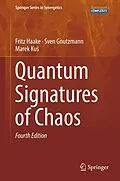This by now classic text provides an excellent introduction to and survey of the still-expanding field of quantum chaos. For this long-awaited fourth edition, the original text has been thoroughly modernized.
The topics include a brief introduction to classical Hamiltonian chaos, a detailed exploration of the quantum aspects of nonlinear dynamics, quantum criteria used to distinguish regular and irregular motion, and antiunitary (generalized time reversal) and unitary symmetries. The standard Wigner-Dyson symmetry classes, as well as the non-standard ones introduced by Altland and Zirnbauer, are investigated and illustrated with numerous examples. Random matrix theory is presented in terms of both classic methods and the supersymmetric sigma model. The power of the latter method is revealed by applications outside random-matrix theory, such as to quantum localization, quantum graphs, and universal spectral fluctuations of individual chaotic dynamics. The equivalence of the sigma model and Gutzwiller's semiclassical periodic-orbit theory is demonstrated. Last but not least, the quantum mechanics of dissipative chaotic systems are also briefly described.
Each chapter is accompanied by a selection of problems that will help newcomers test and deepen their understanding, and gain a firm command of the methods presented.
Zusammenfassung
Nine years have passed since I dispatched the second edition, and the book still appears to be in demand. The time may be ripe for an update. As the perhaps most conspicable extension, I describe the understanding of u- versal spectral ?uctuations recently reached on the basis of periodic-orbit theory. To make the presentation of those semiclassical developments selfcontained, I decided to to underpin them by a new short chapter on classical Hamiltonian mechanics. Inasmuch as the semiclassical theory not only draws inspiration from the nonlinear sigma model but actually aims at constructing that model in terms of periodic orbits, it appeared indicated to make small additions to the previous treatment within the chapter on superanalysis. Less voluminous but as close to my heart are additions to the chapter on level dynamics which close previous gaps in that approach to spectral universality. It was a pleasant duty to pay my respect to collegues in our Transregio- Sonderforschungsbereich, Martin Zirnbauer, Alex Altland, Alan Huckleberry, and Peter Heinzner, by including a short account of their beautiful work on nonstandard symmetry classes. The chapter on random matrices has not been expanded in proportion to the development of the ?eld but now includes an up-to-date treatment of an old topic in algebra, Newton's relations, to provide a background to the Riemann-Siegel loo- like of semiclassical periodic-orbit theory.
